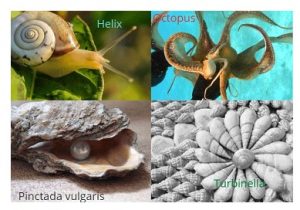Ass. Pro. Dr.: Israa Nasser Ghulam
Department of Biology
college of education for pure sciences, university of Karbala, Iraq.
Temperatures play an important role in the life of living organisms and their bodies, not only molluscs, but all vertebrate and invertebrate animals, and the overall effects are summarized, the most important of which are behavioral ones, where they are more visible, especially in a world full of oddities such as the world of molluscs, so I will highlight in this article the effect and role of temperature in Behaviors belonging to this world in a nutshell,
⦁ Thermal Preference and Activity : Molluscs display specific thermal ranges that influence their vitality and activity patterns. Different species have limits to a distinctive ideal temperature in which they are active. Warm temperatures (high within a certain range) generally improve metabolic rates and motor activity, while cooler temperatures lead to decreased activity or lethargy.[1, 2]
⦁ Feeding and Foraging: Temperature has a direct effect on the feeding style of molluscs. Feeding rates and digestive efficiency increase at higher temperatures. But sometimes severe temperature fluctuations occur, and this in turn may weaken digestion processes, which affects overall growth and energy gain. [3]
⦁ Reproduction and Hatching : Temperature often acts as a major environmental indicator that stimulates reproductive events. High temperatures lead to the start of the mating season and high fertility rates, which leads to early maturity and reproduction.[4]
⦁ Larval development and settling : The growth rate of larvae is highly dependent on temperature, as higher temperatures generally promote faster growth and embryonic development and also affect larval survival and settling success, bearing in mind that some species have specific temperature thresholds for settling and successful metamorphosis. [5].
⦁ Thermal tolerance and adaptation : Molluscs show varying degrees of thermal tolerance, so fluctuations in temperature sometimes exceed their physiological limits and may stimulate stress responses, affect behavior and immunity, and increase susceptibility to disease. [6].
⦁ Environmental interactions : Temperature can have behavioral changes in molluscs and thus have an impact on their ecology. For example, changing feeding patterns for these organisms due to temperature changes affects the availability of food for other organisms in the ecosystem, and thus affects the relationships between predator and prey, which affects the dynamics of population and community structure. [7].
Reffrence :
⦁ Mitra, S., et al. (2019). Thermal preference and behavioral activity of a tropical marine gastropod, Conus inscriptus. Marine Biology, 166(5), 55.
⦁ Leung, K. M. Y., et al. (2018). Behavioral and physiological responses to temperature in the intertidal snail Nucella lapillus. Journal of Experimental Marine Biology and Ecology, 508, 1-8.
⦁ Hawkins, S. J., et al. (2003). Mussels and their role in structuring rocky shore communities. In D. M. Power (Ed.), The Ecology of Molluscs: An Ecological Consequences of Adaptive Radiation (pp. 189-206). Cambridge University Press.
⦁ González-Ortegón, E., et al. (2020). Environmental drivers of reproductive patterns in the wedge clam Donax trunculus. Marine Environmental Research, 161, 105082.
⦁ Ghulam, I. N. (2015). Ecological,Biological and Histological study of the freshwater snails infected with digenean larvae .Unpublished PhD. Thesis. University of Kerbala.Kerbala.Iraq.
⦁ Gaitán-Espitia, J. D., et al. (2017). Thermal physiology and vertical zonation of intertidal marine animals: lessons from the heat. PLoS ONE, 12(9).
⦁ Hawkins, S. J., et al. (2019). Additive and antagonistic interactions among ecosystem engineers drive benthic community responses to changing climate. Journal of Animal Ecology, 88(2), 195-208.
 University of Kerbala
University of Kerbala



























































